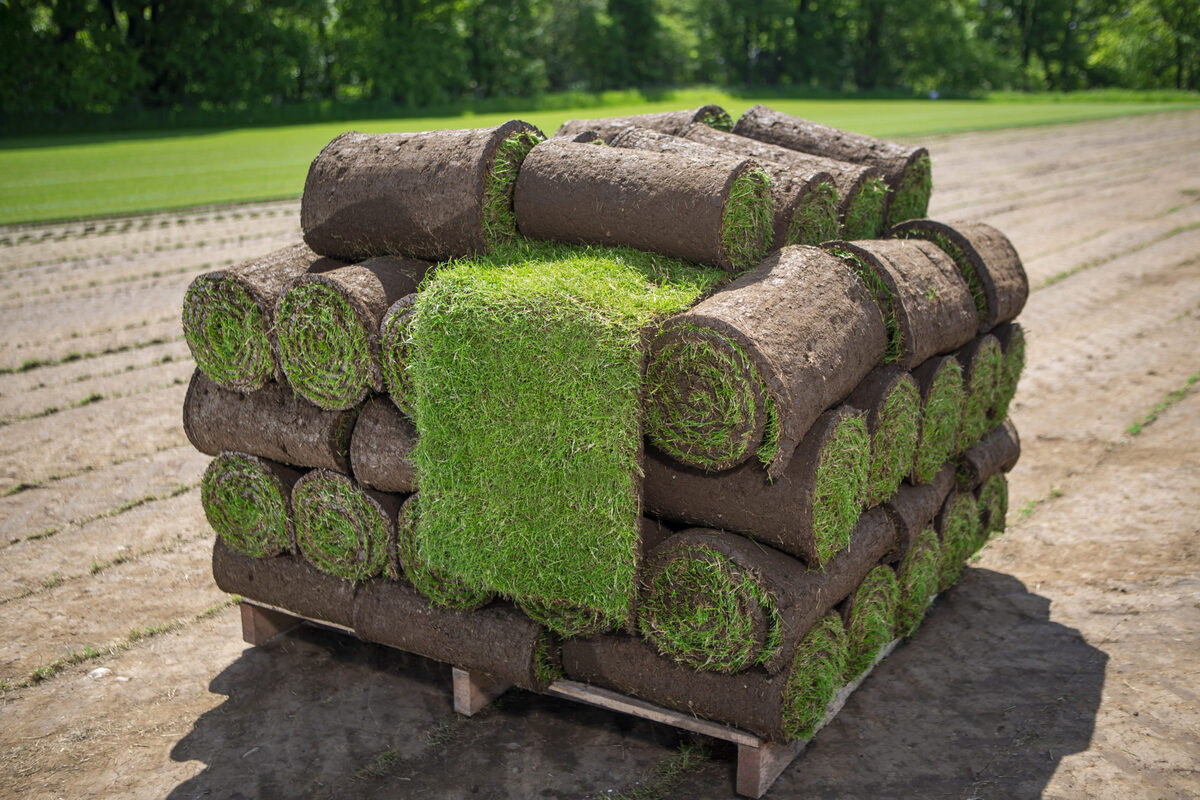Home>Gardening & Outdoor>Landscaping Ideas>How To Get The Best Grass


Landscaping Ideas
How To Get The Best Grass
Modified: October 18, 2024
Learn the top landscaping ideas for achieving the best grass in your yard. Discover expert tips and techniques for lush, healthy lawns.
(Many of the links in this article redirect to a specific reviewed product. Your purchase of these products through affiliate links helps to generate commission for Storables.com, at no extra cost. Learn more)
Introduction
Welcome to the wonderful world of landscaping! Creating a lush, vibrant lawn not only enhances the beauty of your outdoor space but also provides a welcoming environment for relaxation and recreation. Achieving the best grass for your lawn involves a combination of understanding your soil, selecting the right grass seed, proper soil preparation, and diligent maintenance. With the right knowledge and a bit of elbow grease, you can cultivate a stunning lawn that will be the envy of your neighborhood.
In this comprehensive guide, we will explore the essential steps to help you achieve the best grass for your lawn. From understanding your soil to dealing with common issues, we will cover everything you need to know to create a healthy, thriving lawn that you can enjoy for years to come.
So, roll up your sleeves, grab your gardening tools, and let’s dive into the fascinating world of grass cultivation!
Key Takeaways:
- Choose the right grass seed based on your climate, sunlight exposure, and intended use to lay the foundation for a healthy, vibrant lawn that suits your lifestyle and enhances your outdoor space.
- Proper soil preparation, attentive care during grass seed planting, and diligent watering and maintenance practices are essential for fostering healthy, vigorous grass growth and maintaining a stunning, resilient lawn.
Read more: How To Get Grass To Spread
Understanding Your Soil
Before embarking on your journey to achieve the best grass for your lawn, it’s crucial to understand the composition of your soil. Soil type plays a significant role in determining which grass species will thrive in your environment.
Start by conducting a simple soil test. You can either purchase a DIY soil test kit or enlist the services of a professional soil testing laboratory. The test will reveal essential information such as the pH level of your soil, its texture, and nutrient content.
The pH level of your soil is particularly important as it directly impacts the grass’s ability to absorb nutrients. Most grass species prefer a slightly acidic soil with a pH ranging from 6.0 to 7.0. If your soil’s pH deviates significantly from this range, you may need to amend it to create a more hospitable environment for your chosen grass variety.
Next, consider the texture of your soil. Is it predominantly sandy, loamy, or clay-based? Each soil type has its own characteristics, affecting factors such as drainage, aeration, and nutrient retention. For example, sandy soils drain quickly but may require more frequent irrigation, while clay soils retain moisture but can be prone to compaction.
Understanding the nutrient content of your soil is also crucial. Nitrogen, phosphorus, and potassium are the primary nutrients that grass needs to thrive. A soil test will indicate whether these nutrients are present in adequate quantities or if you need to supplement them through fertilization.
By gaining a comprehensive understanding of your soil, you can make informed decisions when selecting the appropriate grass seed and implementing soil amendments. This knowledge will empower you to create an optimal growing environment for your grass, setting the stage for a healthy, resilient lawn.
Choosing the Right Grass Seed
When it comes to selecting the best grass seed for your lawn, it’s essential to consider factors such as climate, sunlight exposure, intended use, and aesthetic preferences. Different grass species have unique characteristics that make them well-suited for specific environments and purposes.
Begin by researching grass species that are well-adapted to your region’s climate. Cool-season grasses, such as Kentucky bluegrass and fescue, thrive in northern regions with cold winters and moderate summers. In contrast, warm-season grasses like Bermuda grass and zoysia excel in southern regions with hot, humid summers and mild winters.
Assess the sunlight exposure in your lawn. Some grass species, such as fine fescue, tolerate shade well, making them ideal for lawns with limited sunlight. Conversely, sun-loving varieties like Bermuda grass and buffalo grass flourish in full sun, providing a lush, resilient lawn in bright, open spaces.
Consider the intended use of your lawn. Are you seeking a durable, traffic-resistant surface for recreational activities and play, or do you prioritize a manicured, ornamental lawn? For high-traffic areas, durable grasses like perennial ryegrass and tall fescue are excellent choices, while fine-textured grasses such as Kentucky bluegrass and fine fescue lend themselves to a more formal, aesthetically pleasing lawn.
Furthermore, factor in your aesthetic preferences. Do you desire a rich, emerald green lawn, or do you appreciate the subtle, variegated hues of different grass species? Some grasses, like Kentucky bluegrass, are prized for their deep green color and fine texture, while others, such as buffalo grass, exhibit a more natural, prairie-like appearance.
Once you’ve identified the characteristics that align with your lawn’s unique requirements, select a high-quality grass seed blend that incorporates the species best suited to your environment and preferences. Look for seed blends that are free of weed seeds and other impurities, ensuring a clean, uniform lawn without unwanted intruders.
By carefully choosing the right grass seed, tailored to your climate, sunlight exposure, intended use, and aesthetic preferences, you lay the foundation for a thriving, visually appealing lawn that suits your lifestyle and enhances your outdoor space.
Preparing the Soil
Proper soil preparation is a critical step in establishing the best possible growing environment for your grass seed. By implementing thorough soil preparation techniques, you can optimize soil structure, promote healthy root development, and create an ideal foundation for your lawn to flourish.
Begin by clearing the area of debris, rocks, and existing vegetation. This allows for a clean, even surface and prevents potential competition for resources between the new grass seed and pre-existing plants or weeds. Once cleared, consider performing a soil cultivation process, such as tilling, to break up compacted soil and improve aeration.
Next, assess the soil’s nutrient content based on the results of your soil test. If the soil lacks essential nutrients, consider incorporating organic matter or targeted fertilizers to enrich its composition. Organic matter, such as compost or well-rotted manure, enhances soil structure, promotes microbial activity, and provides a slow-release source of nutrients for the developing grass.
Additionally, address any pH imbalances identified in the soil test. If your soil is too acidic, apply lime to raise the pH, or if it is too alkaline, amend it with elemental sulfur to lower the pH. Achieving the optimal pH range creates a hospitable environment for nutrient uptake and overall grass health.
Consider the soil’s texture and drainage capabilities. If the soil is excessively compacted or poorly draining, aerate the area to alleviate compaction and improve water infiltration. Aerating the soil enhances root growth and allows oxygen, water, and nutrients to penetrate deeply, fostering a robust root system for your grass.
Finally, create a smooth, level surface by raking and grading the soil. This ensures uniform seed coverage and promotes even germination and establishment. Take care to remove any large clumps or debris that could impede the growth of emerging grass seedlings.
By diligently preparing the soil, addressing nutrient deficiencies, optimizing pH levels, improving soil structure, and creating an even seedbed, you set the stage for successful grass establishment and long-term vitality. Thoughtful soil preparation is a fundamental investment in the health and resilience of your lawn, laying the groundwork for a verdant, thriving outdoor oasis.
Planting the Grass Seed
As you embark on the exciting journey of planting grass seed, attention to detail and proper technique are essential for the successful establishment of a lush, verdant lawn. Whether sowing seed on bare soil or overseeding an existing lawn, following best practices will maximize germination, promote strong root development, and yield a dense, healthy turf.
Before planting, carefully read the instructions on the grass seed packaging to determine the recommended seeding rate for your specific grass species and the coverage area. This information ensures that you achieve the appropriate seed density for optimal growth without overcrowding, which can lead to competition for resources and poor establishment.
When sowing grass seed on bare soil, use a rake to create a finely textured seedbed, breaking up any clumps and ensuring good seed-to-soil contact. This step is crucial for promoting germination and early root development. For overseeding, mow the existing grass to a lower height to improve seed-to-soil contact and allow sunlight to reach the newly planted seeds.
Evenly distribute the grass seed using a broadcast spreader or by hand, taking care to apply half the seed in one direction and the remaining half in a perpendicular direction. This cross-hatching technique ensures uniform coverage and minimizes the risk of patchy areas in the lawn.
After sowing the seed, gently rake the area to lightly cover the seeds with soil, which helps protect them from birds and excessive sunlight while maintaining essential contact with the soil. Firmly press the soil to ensure good seed-to-soil contact, which is vital for successful germination and root establishment.
Water the newly planted seeds with a gentle spray to avoid displacement, and continue to keep the soil consistently moist until the grass seedlings reach a mowing height. Proper irrigation is crucial during this early stage to support germination and initial growth. Avoid overwatering, which can lead to shallow root development and susceptibility to disease.
As the grass seedlings emerge and develop, monitor their progress closely. Once the grass reaches a height suitable for mowing, gradually transition to a regular mowing schedule, taking care not to remove more than one-third of the grass blade in a single mowing session.
By following these planting guidelines and providing attentive care during the germination and establishment phase, you can foster healthy, vigorous grass growth and set the stage for a stunning, resilient lawn that will be a source of pride and enjoyment for years to come.
Read more: How To Get Great Grass
Watering and Maintenance
Proper watering and maintenance practices are essential for nurturing a thriving, resilient lawn that remains lush and healthy throughout the growing season. By implementing a well-structured watering regimen and adhering to sound maintenance techniques, you can promote deep root growth, minimize weed encroachment, and maximize the overall health and beauty of your grass.
Watering is a critical aspect of lawn care, particularly during the initial stages of grass establishment. After planting the grass seed, ensure that the soil remains consistently moist but not waterlogged. Light, frequent watering is recommended to support germination and early growth. As the grass matures, transition to a deeper, less frequent watering schedule to encourage robust root development. Aim to provide approximately 1 inch of water per week, including rainfall, adjusting as needed based on weather conditions and soil moisture levels.
When watering, do so in the early morning to minimize water loss through evaporation and reduce the risk of fungal diseases that can result from prolonged leaf wetness. Avoid watering in the evening, as this can lead to prolonged moisture on the grass blades, creating a favorable environment for disease development.
Mowing your lawn at the appropriate height and frequency is vital for maintaining its health and appearance. Set your mower blade to the recommended height for your grass species and avoid removing more than one-third of the grass blade in a single mowing session. This practice promotes strong root development, reduces moisture loss, and helps shade the soil, minimizing weed germination and growth.
Regular fertilization is essential for replenishing essential nutrients and sustaining vigorous grass growth. Choose a high-quality, slow-release fertilizer formulated for your specific grass type and apply it according to the manufacturer’s recommendations. Fertilizing in early spring and late fall provides the nutrients necessary for sustained health and vitality, promoting dense, resilient turf.
Periodic aeration of the soil is beneficial for relieving compaction, improving water and nutrient infiltration, and enhancing root development. Consider aerating your lawn annually, particularly if it experiences heavy foot traffic or shows signs of soil compaction.
Vigilant weed control is crucial for maintaining a uniform, healthy lawn. Regularly inspect your lawn for weeds and address them promptly to prevent them from competing with the grass for resources. Consider employing targeted herbicides or manual removal for persistent or widespread weed infestations.
By diligently adhering to proper watering practices, regular mowing, strategic fertilization, periodic aeration, and vigilant weed control, you can cultivate a vibrant, resilient lawn that serves as a verdant canvas for outdoor enjoyment and relaxation.
Dealing with Common Issues
While nurturing a lush, healthy lawn is a rewarding endeavor, it’s not uncommon to encounter various challenges along the way. From pest infestations to disease outbreaks, understanding and effectively addressing common issues is essential for preserving the beauty and vitality of your grass. By recognizing the signs of potential problems and implementing targeted solutions, you can safeguard your lawn from common issues and maintain its lush, resilient appearance.
Pest Infestations
Keep a watchful eye for signs of pest infestations, such as discolored patches, thinning turf, or visible pests on the grass blades. Common lawn pests, including grubs, chinch bugs, and armyworms, can wreak havoc on your lawn if left unchecked. Consider employing targeted insecticides or natural pest control methods to address infestations and prevent further damage.
Weed Encroachment
Weeds can detract from the uniformity and health of your lawn. Regularly inspect your lawn for weed growth and implement effective weed control strategies, such as targeted herbicides, manual removal, or the use of pre-emergent herbicides to prevent weed seeds from germinating.
Read more: How To Get Sea Grass
Disease Outbreaks
Fungal diseases, such as brown patch and dollar spot, can manifest as discolored or dead patches in the lawn. Proper watering practices, adequate air circulation, and strategic fungicide applications can help mitigate and prevent the spread of lawn diseases.
Thatch Accumulation
Thatch, a layer of organic debris that accumulates between the grass blades and soil, can impede water and nutrient penetration and create a hospitable environment for pests and diseases. Regular dethatching or core aeration can help manage thatch accumulation and promote a healthy, resilient lawn.
Soil Compaction
Compacted soil can hinder root growth and water infiltration, leading to stressed, lackluster turf. Consider aerating your lawn to alleviate soil compaction and promote robust root development and overall grass health.
Improper Mowing Techniques
Mowing your lawn too short or infrequently can weaken the grass and make it more susceptible to stress, disease, and weed encroachment. Adhere to the recommended mowing height for your grass species and maintain a regular mowing schedule to promote healthy, resilient turf.
By promptly identifying and addressing common lawn issues, you can preserve the health and beauty of your grass, ensuring that it remains a vibrant, inviting centerpiece of your outdoor space. With proactive management and targeted solutions, you can overcome challenges and maintain a stunning, resilient lawn that enhances your outdoor environment.
Water your grass deeply and infrequently to encourage deep root growth, mow at the proper height for your grass type, and fertilize according to the specific needs of your lawn.
Read more: How To Get Green Grass
Conclusion
Cultivating a lush, vibrant lawn is a gratifying pursuit that enhances the beauty of your outdoor space and provides a welcoming environment for relaxation and recreation. By following the essential steps outlined in this guide, you can achieve the best grass for your lawn and create a verdant, resilient turf that brings joy and pride for years to come.
Understanding your soil and selecting the right grass seed tailored to your climate, sunlight exposure, intended use, and aesthetic preferences forms the foundation for a successful lawn. Thorough soil preparation, including addressing nutrient deficiencies, optimizing pH levels, and improving soil structure, sets the stage for robust grass establishment and long-term vitality.
Planting the grass seed with precision, providing attentive care during the germination and establishment phase, and implementing sound watering and maintenance practices are essential for fostering healthy, vigorous grass growth. Diligent monitoring, proper mowing, strategic fertilization, and vigilant weed control contribute to the ongoing health and beauty of your lawn.
Recognizing and effectively addressing common issues, such as pest infestations, weed encroachment, disease outbreaks, thatch accumulation, soil compaction, and improper mowing techniques, allows you to safeguard your lawn and maintain its lush, resilient appearance.
As you embark on this journey, remember that patience, attentiveness, and a bit of trial and error are integral to achieving and maintaining a stunning lawn. Embrace the process, learn from the challenges, and celebrate the successes as you nurture a vibrant, inviting centerpiece for outdoor enjoyment and relaxation.
With the knowledge and insights gained from this guide, you are well-equipped to embark on your quest for the best grass, creating a flourishing, resilient lawn that serves as a source of pride and natural beauty in your outdoor oasis.
Frequently Asked Questions about How To Get The Best Grass
Was this page helpful?
At Storables.com, we guarantee accurate and reliable information. Our content, validated by Expert Board Contributors, is crafted following stringent Editorial Policies. We're committed to providing you with well-researched, expert-backed insights for all your informational needs.













0 thoughts on “How To Get The Best Grass”